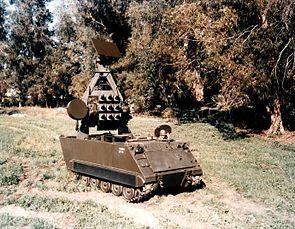MIM-46 Mauler
| MIM-46 Mauler | |
|---|---|
| General Information | |
| Type | Anti-aircraft missile |
| NATO designation | MIM-46 Mauler |
| Country of origin |
|
| Manufacturer | General Dynamics |
| development | 1960 |
| Commissioning | Development aborted |
| Technical specifications | |
| length | 1.83 m |
| diameter | 127 mm |
| Combat weight | 54.5 kg |
| span | 330 mm |
| drive | Solid rocket engine |
| speed | Mach 3.0 (1,000 m / s) |
| Range | 8 kilometers |
| Service ceiling | 6,000 m |
| Furnishing | |
| steering | INS |
| Target location | semi-active radar target search (SARH) |
| Warhead | 8.6 kg fragmentation warhead |
| Detonator | Proximity fuse or impact fuse |
| Lists on the subject | |
The MIM-46 Mauler was an American short-range anti-aircraft missile system from the 1960s that never got beyond the project stage.
Development history
In the late 1950s, the US Army announced the need for an autonomous short-range anti-aircraft missile system. General Dynamics was commissioned to develop such an air defense system called "Mauler". At the same time, Great Britain expressed interest and wanted to buy the new weapon.
With the "Mauler" system, all the necessary components such as search radar , fire control system and missiles are on one vehicle. The first tests of unguided missiles took place in September and December 1961. Test series with guided missiles were successfully carried out in June 1963. In the same month the additional designation XMIM-46A was added. The prefix "X" stood for experimental and would not have been used until it was introduced into the US Army.
The whole project faced many difficulties from the start. For example, the construction of the 3 × 3 launch container was problematic because when a guided missile was fired from a container chamber, adjacent chambers and the missiles contained therein were damaged. In addition, deficiencies in the missile itself were found, such as problems with the missile hull and difficulties with the aerodynamics of the missile. There were also errors in the fire control system, so contact with the missile was often lost shortly after the launch.
These problems eventually led to the discontinuation of the project in November 1965. Attempts were still made to develop less complicated variants, which also did not lead to any result. It was also not possible to develop a sea-based surface-to-air variant of the system, the RIM-46A Sea Mauler , for the US Navy . Instead, the RIM-7 Sea Sparrow anti-aircraft missile system with radar, supersonic , was chosen .
As a replacement for MIM-46 Mauler was MIM-72 Chaparral -Flugabwehrraketensystem developed that the proven air-to-air missile as guided missiles, AIM-9 Sidewinder used, which, however, otherwise not radar-MIM-46, but was infrared guided. Due to the failure of the MIM-46 Mauler project, purchase negotiations with Great Britain were also terminated. The MIM-72 Chapparal system did not meet the British expectations. The British developed their own system, the Rapier surface -to-air missile , which in turn featured radar-controlled remote control.
technology
The rockets were fired from the XM546 starter vehicle , a modified M113 . Each XM546 carried nine guided missiles, which were located in a rectangular container. The TI CW (TI: Tracking and Illumination, CW : continuous wave) radar was located above and next to the 3 × 3 launch container. The fired missile was guided by the TI radar throughout the flight phase until the proximity fuse detonated the missile.

